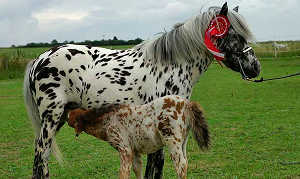 Over the last few months I’ve been working my way through the colors section, providing some new information and bigger images. I’ve almost made my way through the white patterns – next comes markings!
Over the last few months I’ve been working my way through the colors section, providing some new information and bigger images. I’ve almost made my way through the white patterns – next comes markings!
White Patterns
There are a handful of white patterns that can affect the base colors as well as those affected by modifiers and dilutions (or even other white patterns). Today I want to share a little about the appaloosa white pattern which is responsible for an amazing variety of lively spotted animals.
Appaloosa White Pattern
The appaloosa patterns are expressed through the Leopard Complex which can appear on both chestnut and black bases. It varies a great deal in expression and some animals can even display more than one pattern.

Appaloosa Terminology
There are a wide variety of patterns that vary from animal to animal, however most appaloosas will display at least one of a few characteristics. They may have mottled skin around their mucus membranes, white sclera, striped hooves or a rat tail.
Appaloosa Patterns
There are several different patterns that are associated with the Leopard Complex, each one with their own specific patterns and characteristics.

Leopard – These animals are white with dark base colored spots distributed throughout the coat – like a dalmatian. Spots are often concentrated on head and legs.
Few Spot Leopard – This is the maximum expression of the Leopard Complex and creates a white animal with a few dark base colored spots on their coat – generally on the flank, elbow, neck and head.
Blanket – The most common pattern, blanket animals are a dark base color with a blanket of white across the hindquarters and there must be spots in the blanket.
Snowcap – Similar to blanket appaloosas except that there are no spots inside the blanket of white. A snowcap blanket can extend across most of the body, but they usually retain their base color on head, legs, flanks and elbows.
Frost – Can be mistaken for roan, a frost appaloosa looks similar to roans except they will not retain dark points as they age. This pattern generally occurs along the topline and hips.
Snowflake – This pattern does not display a blanket across the hindquarters but rather flecks of white across the body. This pattern has a tendency to grow lighter as it ages.
Marble or Varnish – This pattern mimics the effects of an actual roan and is often mistaken for it, however it comes from the Leopard Complex. Generally they are born dark and begin to blur or fade lighter as they age. Similar in practice (but not) the grey coat modifier.
Each pattern has its own distinguishing factors, but all of them produce fantastic animals!
Learn More About Color
Be sure to visit the new and improved color section for more information about appaloosa horses and stay tuned, next week we’ll take a look at the rabicano white pattern (often mistaken for appys).
Would like to see photos of Blanket Appaloosas. Thx.